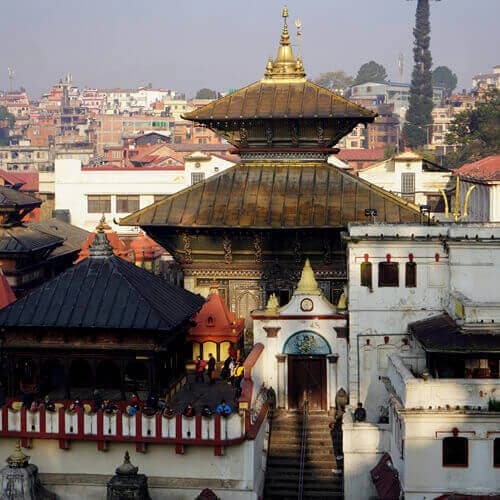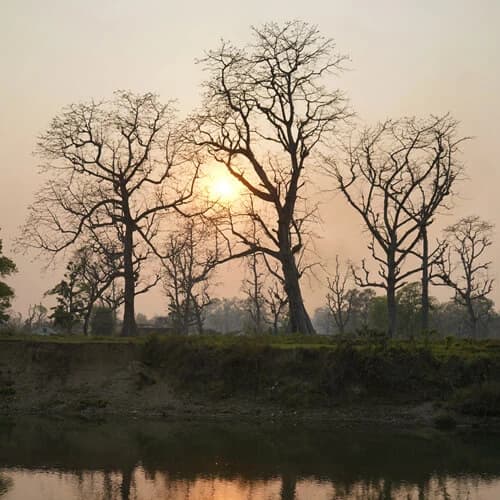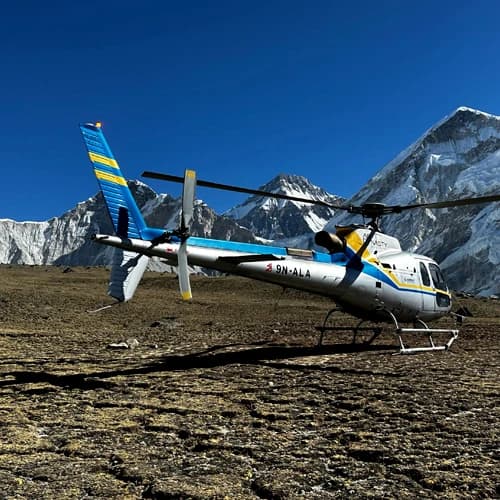How to Book this trip
You can reserve your seat in the Kanchenjunga North Base Camp Trek by paying a 10% deposit fee of the total cost. This ensures the coverage of administrative fees and makes your travel seamless and hassle-free. We accept deposits via bank transfer, credit/debit card, and online transfer. You can make the rest of the payment at our office after you arrive in Kathmandu, Nepal. Please remember to send a copy of your passport, travel insurance, two passport-size photos, and flight tickets before departing from your country.
Note: You can alter our trek package to suit your interests and preferences. Please let us know and contact us by WhatsApp or email if you want a customized Kanchenjunga North Base Camp Trek Package.
Best Seasons for the Kanchenjunga North Base Camp Trek
The best time for the Kanchenjunga North Base Camp Trek is spring (March, April, and May) and Autumn (October, November, and December). These two seasons are the peak time for traveling in Nepal. It offers stable weather conditions and optimal temperatures for trekking and outdoor activities in the Kanchenjunga region.
- Spring (March, April, and May): This is the peak season to travel and trek in Nepal, as it offers the best weather conditions with minimum snow and rainfall. However, remember that you might experience sudden downpours at higher elevations. This is caused due to the unpredictable nature of the climate at such high altitudes. During this time of the year, the temperature ranges around 5°C to 15°C in the lower regions and can drop to -10°C at night. The landscapes will be blooming with wildflowers and colorful rhododendrons, which add to the overall aesthetic of the region.
- Autumn (September to November): Like spring, the autumn season in Nepal is the best time for travel, trekking, and other outdoor activities. The temperature averages around 15°C and rises to a maximum of approximately 20°C. It arrives after the end of the monsoon rain, which clears the dust and smoke from the atmosphere. This causes the sky to be crisp and clear, offering pristine views of the green hills and snow-capped mountains. Some of Nepal's leading festivals, such as Dashain and Tihar, fall during these months, which you can experience during your travels.
Note: As mentioned earlier, the weather in the Kanchenjunga region can be unpredictable. So, it is essential for travelers to be prepared for all weather-related events, such as rainfall, blizzards, snow, and wind storms.
Kanchenjunga North base camp trek difficulty
Kanchenjunga North Base Camp Trek is classified to be one of the most challenging treks in Nepal. During this Himalayan expedition, you must hike on several rugged and rocky terrains in high-altitude regions. Also, remember that most of the trail lies within the rural parts of eastern Nepal, which adds to the overall difficulty of the trek. Here are some other factors that you must consider before embarking on this challenging yet rewarding off-beaten trek in Nepal.
- High Altitude: The multi-day hike reaches a maximum elevation of 5,153m, which can cause altitude sickness in travelers who ascend without proper acclimatization.
- Remote trails: The trek trail passes through some of Nepal's most isolated regions, with limited infrastructure and facilities. This allows you to be self-sufficient most of the time and avoid major injuries on the trail.
- Unpredictable Weather: At higher elevations, trekkers might experience sudden downpours of rain, snow, hail, and windstorms. You need to pack the appropriate gear and equipment to face such situations.
- Basic Accommodation: The tea houses in high-altitude regions are simple with limited amenities. You must step out of your comfort zone and embrace new experiences in the Himalayas.
- Long Trekking Days: The journey lasts 16 days, with daily hikes of approximately 6 to 8 hours. Covering such a distance will require good physical endurance and mental resilience.
Note: If you are a beginner trekker without prior experience in high-altitude trekking, we encourage you to join the adventurous trek to Kanchenjunga. Our expert team members will provide you with the necessary guidance and preparation and help you get ready quickly.
Ideal Candidate for the Kanchenjunga North Base Camp
Trekking to the base camp of Mount Kanchenjunga is suitable for physically fit and healthy participants. It must also be noted that the trek is recommended for the age group between 16 and 60 because of its challenging nature. Here are some other factors you must consider before deciding if the Kanchenjunga North Base Camp trek suits you.
- The journey involves arduous hiking on varied terrains, requiring good physical fitness.
- You have to ascend elevation above 5,000m, which can be challenging for individuals not exposed to high-altitude conditions.
- The challenging journey requires not only physical endurance but also a sense of adventure and a mindset to push yourself to the limits.
- The trail passes some of the most remote and rugged landscapes, making it best suited for outdoor enthusiasts and nature lovers.
- We recommend that travelers be open-minded and respectful of cultural encounters with the native people. For an immersive experience, it is also advised that travelers partake in their traditional lifestyle.
Note: It is recommended that all interested participants consult a healthcare professional. This ensures that any underlying conditions they might have won't negatively affect them during the journey.
Preparation for the Trek to the North Base Camp of Kanchenjunga
The Kanchenjunga North Base Camp Trek Nepal is a challenging yet rewarding Himalayan journey requiring moderate physical fitness. If you are someone who has no prior trek experience and needs advice on making the necessary preparations, please reach out to us. Generally, we encourage all interested trekkers to start working out 3 months before departure. It allows your body to enhance stamina, durability, and flexibility to endure the multi-day hike. For starters, you can incorporate the following guidelines in your workout routine.
- Brisk walks, jogs, and runs on treadmills to stimulate hiking at higher elevations.
- Strengthen your core muscles with sit-ups, squats, jumping jacks, and weight-lifting exercises.
- Indulge in cycling, swimming, and skipping ropes to enhance your stamina.
- Practice stretching and yoga to enhance the mobility and flexibility of the body.
- We encourage you to maintain a nutritious diet to help your body replenish and recover from the physical exercises.
Altitude Sickness and It’s Remedies
The risk of altitude sickness is certainly high during the trek to the north base camp of Kanchenjunga. You will be spending multiple days at an altitude above 2,500 m, which can cause Acute Mountain Sickness (AMS) in some individuals. Travelers who do not acclimatize to the elevation gain or stay hydrated are more prone to suffering from the illness. It is a pathological condition of the body which is caused due to the lower concentration of oxygen in the atmosphere. Some of the early signs of suffering from altitude illness include:
- Headache, nausea
- Dizziness, lightheadedness
- Fatigue
- Shortness of breath
- Insomnia
In all honesty, altitude sickness is common while trekking in high-altitude regions. However, if the symptoms do not subside, you must be evacuated immediately to the nearest health facility. Here are some preventive measures you can follow to avoid the development of altitude sickness:
- Take sufficient time to acclimatize, as this allows your body to adapt to the increasing elevation and decreased oxygen levels.
- Stay hydrated by drinking at least 2-3 liters of water daily.
- Try to sleep for 7-8 hours per night to allow your body to rest and recover from the physical exertion.
- Consume foods high in nutrients and carbohydrates, like green vegetables, lentils, and rice.
- Take medications like Diamox as per the consultation of a healthcare professional.
- We also encourage you to drink natural remedies like lemon tea, garlic soup, and ginger tea.
Travel Tips (electricity, internet, ATM, luggage, tipping, personal expenses)
- You can charge your electronic gadgets at the tea houses during the trek. However, you will have to pay a small amount, $2-$4 per charge, depending on the location.
- We advise buying Nepali SIM cards like Ncell and NTC at the Tribhuvan International Airport or local stationeries. You can use it for internet usage and making calls within the country.
- Withdraw enough cash for snacks, beverages, and personal expenses to last the trek.
- The luggage limit for domestic flights is 15 kg, including hand carry. If the weight limit is exceeded, you will be charged accordingly.
- Our porter/helper carries 22 kg of luggage for two travelers, and if your luggage exceeds the limit, you will have to pay extra.
- We highly encourage you to tip our valued staff members, including our guide, porter/helper, and driver, for their hard work and dedication.
Trip Extension
Want to explore more of Nepal's wildlife and nature? Then we can provide you with the best package for you. We highly recommend you explore Koshi Tappu Wildlife Reserve in eastern Nepal, where you can relax after a great adventurous trek. It is located 108km.67 miles from Bhadrapur, Biratnagar. Here, you can enjoy a peaceful time with nature immersed in its raw beauty and serenity.
Why trek with Outfitter Nepal?
Our well-paced trek itinerary is thoughtfully curated with strategically placed acclimatization stops for your safety and well-being. Additionally, our packages are high value for money and provide a unique experience of the Nepalese Himalayan wonders. In this 16-day adventure in the remote off-beat trails, you will travel with expert guides with extensive knowledge of the region. With their help, we will assure you that your safety is safe and that you will have a well-balanced journey of enjoyment and adventure.




